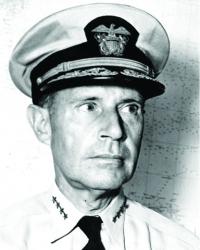
Adm. Raymond A. Spruance, commander of Task Force 16, which included carriers Enterprise and Hornet at Battle of Midway.
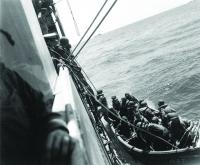
Rear Adm. Fletcher, commander of U.S. forces during Battle of Midway, transferring to cruiser Astoria after his flagship Yorktown was damaged.
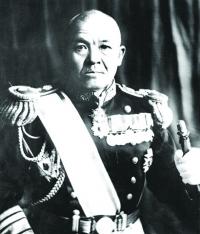
Adm. Chuichi Nagumo
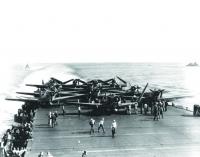
Devastator torpedo preparing to launch from Enterprise.
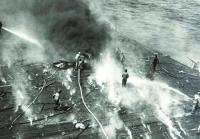
Fighting fire on the Yorktown, June 4, 1942.
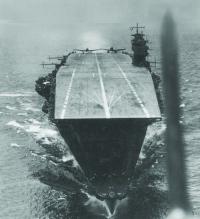
Akagi deck, April ‘42
Shortly after Japan’s successful strike upon Pearl Harbor, Japanese Admiral Isoroku Yamamoto, the mastermind of the attack, was quoted as saying, "I fear all we have done today is to awaken a great, sleeping giant."
While Japan’s attack did drag America into World War II, the “sleeping giant” was facing an enemy that was rolling to victory all across Asia & Oceania. In the Philippines, the Japanese destroyed much of the American air force and routed the army. With no effective opposition, the Japanese quickly conquered Malaya, Singapore, Burma & the Dutch East Indies. With resource rich Southeast Asia under its control, the Japanese military looked to create a perimeter to defend the newly won territories.
Creating that perimeter to defend the Japanese home island became more of a priority after the Doolittle Air Raid in April 1942. While the raid did little damage, it exposed Japan’s vulnerability to Allied bombing and gave a boost to American morale.
After the Doolittle raid, Admiral Yamamoto began to plan an operation to destroy the U.S. Fleet once and for all. Yamamoto wanted to create a diversion in the Aleutians so his forces could occupy the tiny island of Midway. This would be a stepping stone for Japan to capture the Hawaiian Islands and cut the main supply route to Australia. The plan had Vice-Admiral Chuichi Nagumo’s First Air Fleet playing the decisive role in destroying the American Fleet and the capture of Midway. Vice-Admiral Nagumo was coming off a string of successful battles that included the attack on Pearl Harbor, the bombing of Darwin and a sortie into the Indian Ocean that crippled the British Eastern Fleet.
Unknown to Yamamoto and his admirals, the Americans had cracked the main Japanese naval communication code. The breaking of the code gave the United States vital intelligence regarding the movement and strength of the Japanese attack force.
Knowing the relative strength of the Japanese Fleet heading toward Midway Island, American Pacific Fleet Admiral Chester Nimitz scrambled to get as many carriers into position as possible. The Yorktown, damaged in the Battle of the Coral Sea, was hurriedly repaired at Pearl Harbor and sent to join the carriers Enterprise and Hornet. On Midway, the United States beefed up its total aircraft on the island to 124.
With four carriers under his command, Admiral Nagumo sent his aircraft to attack the airfield on Midway on June 3, 1942. As his aircraft were underway, an American search plane spotted his carriers. American Admiral Frank Fletcher ordered an immediate attack on the Japanese carrier fleet.
After his planes arrived back from their attack on Midway, the returning pilots encouraged Nagumo to go back for a second strike. Unaware of any American fleet in the area and mindful of his failure to order a third strike that could have destroyed Pearl Harbor’s port facilities back in December 1941, Nagumo ordered his planes to be armed and sent back to Midway.
As his planes were being rearmed and fueled, a Japanese reconnaissance plane spotted the American fleet and its three carriers. Dithering for fifteen minutes, Nagumo finally ordered that his planes be refitted with torpedoes and armored piercing bombs to attack the fleet. As the Japanese planes were being rearmed on top of the carrier decks, American torpedo bombers came in low to attack the carriers. Slow moving and without fighter protection, the American planes were cut to pieces without scoring one hit.
Just as the last of the torpedo bombers were finished off, dive bombers from the USS Enterprise arrived overhead. The Enterprise, out to sea at the time on maneuvers, was one of the carriers Nagumo hoped to destroy during his attack on Pearl Harbor. With their decks covered in ordinance from the changeover and the air cover low defending against the torpedo planes, the dive bombers came in relatively unopposed. Within minutes, the Japanese carriers Kaga and Akagi were in flames as the dive bombers ignited the refueled planes and ammunition. Seventeen more dive bombers arrived from the USS Yorktown. These planes put three 1000-pound bombs into the Japanese carrier Soryu, turning it into a flaming wreck.
With only one carrier remaining, Admiral Nagumo launched an attack on the American fleet. Following the American aircraft home, the Japanese bombers put three bombs and two torpedoes into the USS Yorktown. The remaining Japanese carrier, the Hiryu, was sunk by 24 American dive bombers.
While the Yorktown was trying to be saved, a Japanese submarine launched several torpedoes into it causing it to roll over and sink. In the same attack, an American destroyer was also hit by a torpedo and sunk.
The last of the air attacks occurred on June 6th when planes from the Hornet and Enterprise attacked and sunk the Japanese heavy cruiser Mikuma. The attack also damaged two Japanese destroyers and a cruiser.
After losing 4 carriers, 1 cruiser, 248 aircraft and over 3,000 dead, Admiral Nagumo and the remnants of his First Air Fleet were forced to retreat to the relative safety of Japan’s home waters. The missing carrier from Pearl Harbor was instrumental in bringing about Nagumo’s first defeat.
The Battle of Midway was considered the turning point of the war in the Pacific. Losing only one carrier and one destroyer, the United States decisively defeated the Japanese Navy. All four Japanese carriers that were sunk at Midway took part in the attack on Hawaii. It only took seven months for the “sleeping giant” to awaken and avenge the Japanese destruction of the battleships at Pearl Harbor.
«Go back to the previous page.





